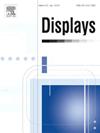智能座舱透明微型led显示屏可读性评估数据集与模型
IF 3.7
2区 工程技术
Q1 COMPUTER SCIENCE, HARDWARE & ARCHITECTURE
引用次数: 0
摘要
在日益先进的汽车智能座舱中,对具有高可读性和在各种观看方向下愉悦的观看体验的显示的要求,给产品制造和改装带来了重大挑战。微发光二极管(micro- led)显示屏具有功耗低、色域宽、寿命长、芯片尺寸小等特点,是设计下一代浸入式车载显示屏的理想选择。然而,这些显示器应该能够在广泛的车内和车外照明条件下运行,这使得评估设置的设计更具挑战性。在本文中,我们研究了一种新的基于仿真的透明微型led显示屏评估框架。具体而言,我们通过全面的主观研究收集了第一个显示可读性数据集。基于此,我们提出了一种新的客观显示可读性评估模型,该模型由三个分支组成,旨在提取与可读性相关的特征,包括场景语义、技术扭曲和显着屏幕区域。在实验中,我们在提出的显示可读性数据集上评估了各种盲图像质量评估算法,包括手工制作的基于特征的模型和基于深度学习的模型。结果表明,本文提出的客观显示可读性评价方法的有效性优于其他基准的主观一致性。消融研究进一步证明了所提出的多分支特征提取策略和图像预处理方案在滤除可读性无关信息方面的有效性。本文章由计算机程序翻译,如有差异,请以英文原文为准。
A dataset and model for the readability assessment of transparent micro-LED displays in smart cockpit
In the increasingly advanced automotive smart cockpit, the requirements for display with high readability and pleasant viewing experiences under various viewing directions, lead to significant challenges in product manufacture and modification. The micro light-emitting diode (micro-LED) display which has outstanding features, such as low power consumption, wider color gamut, longer lifetime, and small chip size, makes it a perfect candidate to design next-generation immersion vehicle display. However, the wide range of in- and out-vehicle lighting conditions that these displays should be able to operate in, makes the design of the evaluation set-up even more challenging. In this paper, we investigate a novel simulation-based evaluation framework for transparent micro-LED displays. Specifically, we collect the first display readability dataset by conducting comprehensive subjective studies. Based on this, we propose a novel objective display readability assessment model, which is comprised of three branches that are designed to extract readability-related features including scene semantics, technical distortions, and salient screen regions. In the experiments, we evaluate various blind image quality assessment algorithms, including both handcrafted feature-based models and deep learning-based models, on the proposed display readability dataset. The results show the effectiveness of our proposed objective display readability evaluator that achieves better subjective consistency than other baselines. The ablation studies further demonstrate the effectiveness of the proposed multi-branch feature extraction strategy and the image pre-processing scheme to filter out readability irrelevant information.
求助全文
通过发布文献求助,成功后即可免费获取论文全文。
去求助
来源期刊

Displays
工程技术-工程:电子与电气
CiteScore
4.60
自引率
25.60%
发文量
138
审稿时长
92 days
期刊介绍:
Displays is the international journal covering the research and development of display technology, its effective presentation and perception of information, and applications and systems including display-human interface.
Technical papers on practical developments in Displays technology provide an effective channel to promote greater understanding and cross-fertilization across the diverse disciplines of the Displays community. Original research papers solving ergonomics issues at the display-human interface advance effective presentation of information. Tutorial papers covering fundamentals intended for display technologies and human factor engineers new to the field will also occasionally featured.
 求助内容:
求助内容: 应助结果提醒方式:
应助结果提醒方式:


